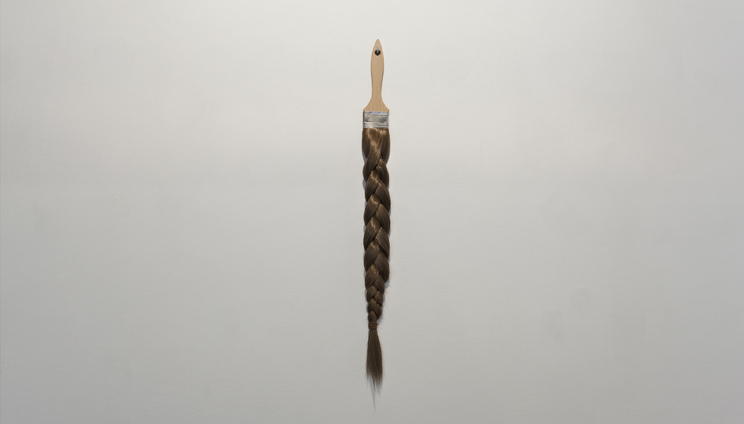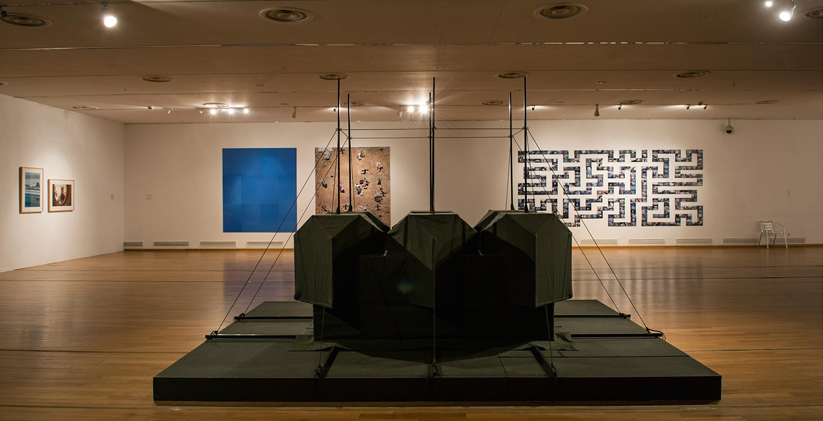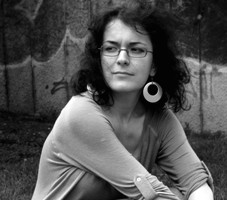In 2014 I witnessed a lot of new art spaces with beautiful architecture pop up. A lot of them are houses that belonged to the high and small Bucharest bourgeoisie and they are quite beautiful: for example, the new Nicodim Gallery in the Cantacuzino Palace (or the “Nababului”), the present day George Enescu museum (a new gallery that hosted the opening for the Apparatus 22 exhibition, an artist collective that cultivates images and materiality with each new project – they had a beautiful and immersive installation at The Museum of Contemporary Art MNAC, Uncertain Scripts). Another: The Eastward Prospectus Gallery, inaugurated by the Cluj-based artist Radu Cioaca, is full of good pieces (maybe a little too full), everything happening under a brick arcade basement that is also used artistically. Or different: the Anca Poteraşu Gallery, the new two-story art space (where glass painted red lipped males slumbered amidst exotic vegetation, smell of spices and wet grass that you can walk on, between 4 sweet-blue walls we have Lea Rasovszky’s males in From starts to steroids, curated by Anca Mihuleţ). Or: Tipografia Hall that belonged to the old Combinatul Fondului Plastic – without a doubt one the cool places that will become very sought after in Bucharest, a different kind of Fabrica de Pensule (The Paintbrush Factory). I’m surprised it’s not already explored and solicited as it should be (only the promising itinerary gallery Alegra Nomad has shown interest so far). And since we’re talking about cool spaces, The Unicredit Pavilion on Jean-Louis Caldreon Street was just like that not so long ago. It was a poorly used space despite its many qualities, but it was just as resourceful as Old Town’s Atelier 35 appeared to be at one point (another great space, but “problematic” as some would put it). This is how the newly reformed Pavilion team (whose BB, the Bucharest Biennale, is also reforming under a new alter-ego, BFB, the Bucharest Film Biennale) sees things. There are also the “one-night stand spaces”, circumstantially empty palaces normally closed to the general public that open up for one day (or night) and you get the chance to see what they look like from the inside. Masaryk 25 is a wonderful example of a space that can host painting exhibitions that look amazing in bourgeois rooms: Nicolae Comănescu (during NAG#8) and Vioara Bara (Thorn honey: part of the exhibition was curated by Erwin Kessler under H’art, while the other part was hosted by the gallery). It’s as if our strong female artists would go back to paint, color and image: Vioara Bara, Anca Mureşan, Ioana Bătrânu, Ecaterina Vrană, Suzana Dan, Marilena Preda-Sânc (in an age where it is said that feminism is making a comeback in art, in many different forms). Just as strong as Alma Redlinger, Wanda Sachelarie Vladimirescu, Lola Schmierer Roth (now, when grand ladies like the artists Etel Adnan, Maria Lassnig, Louise Bourgeois, Elaine Sturtevant, Geta Brătescu are being courted and rediscovered, when grand ladies are “hip” again). And speaking of palaces and strength, Suzana Dan set up a House in a Palace (Casă-n palat, the name of the show), to later bring tapered breasts, shiny fresh-smelling oils, vaginas, penises, pinkish carnal curiosities, flames, heart-tongues with dripping red streaks, her great old painting that is easily recognizable as the pink that perversely creeps into your own fantasies, in another beautiful house at Aiurart (Playground, curated by Erwin Kessler).
Another circumstantially empty palace, Palatul Bursei (The Stock Market Palace), was the one that hosted The National Library for years before it moved to the Samsung building on the Dâmboviţa River. This is where architect Atilla Kim organized (with the help of a few works from The Project 1990 by Ioana Ciocan) Romanian Design Week, an interesting, although a bit too big to take and swallow, mega installation (but with a special hit – a warm, nostalgic, sentimental exhibition of socialist templates design that was hosted in another great palace that is also fancied by art folk, the Ştirbei Palace – it is a great building with a garden where nature totally took over). Horia Bernea had a retrospective at Mogoşoaia Palace (where I saw the painter Constantin Diţoiu, who completely surpassed his master), but I’ve seen some great looking works of his at Ivan Gallery as well (where I visited Andrea Ciobâcă’s drawing installation this year). I never liked the frame for Mircea Spătaru’s drawing, the main piece in the show In between the lines at Plan B Gallery in Cluj, but I did like the idea behind the show and the way it was set up (Atilla Kim again), I enjoyed the small thorny object by Mihai Oslo that was meant to be an instant of the drawing, as well as Andrea Ciobâcă’s sponge which was placed in a conceptual proximity to the drawing (I also enjoyed the text that documented and promoted the show; it had a few lines on the particularity of the drawing that were excellent).
Ştefan Râmniceanu at Mogoşoaia – I knew him from Aurelia Mocanu’s course on Romanian artistic migration from a few years back at UNARTE: materiality, textures, steel, sculpture (I think it’s better than his symbolist painting), book assemblages, rusty metal beasts and a lot of spirituality (I thought about Silviu Orăviţan, another migrator, and Marin Gherasim’s red and gold). I never really understood why the older generations prefer to include a self-documentation (instead of placing it in an auxiliary, separate, decent space) without warning, right in the middle of the show. In this case there was video footage of Râmniceanu’s opening nights (it’s true, it’s an anthology – these are meaningful shows for the artistic community, set in a meaningful place such as Curtea-Veche) presented as triumphal clips with Vanghelis (!?) music on the background.
I keep seeing people that migrated making a comeback (just like the comeback of Romanian women artists with testosterone running through their veins). These are “senior” comebacks, as they like to call themselves. It is Romanian art from a different era, but it is, in some ways, typical. We are, in a way, under the “young generation’s” dictatorship, as those same seniors taunt us. It’s a time when the highlight, the attention and the predominant and aprioristic interest falls on the young worker and artist by default and sometimes undeserving, just because he is young. This is an echo in the art world and the real world: even beyond art, people generally value (and exploit) youth as opposed to seniority or maturity. Everything that’s going on, every call, every “white night”, every institution, and every event that matters is catered to young people. You figure this out when it’s already too late, when you, yourself aren’t that young anymore. And it feels anguishing: what is happening to the mass majority of the art seniors? Where are they? Where will we be after a while? The years go by and we’re not that young anymore; what kind of visibility and addressability will we have after a while and then some?
Since we were discussing about femininity, I enjoyed The mystery supper by Flavia Lupu, a last supper with the artist surrounded by men in corporate suits (I am the spoiled daughter of a politician, Victoria Art Center, curated by Olivia Niţiş). I was also very touched by Michele Bressan’s Madonna in the exhibition Pasaj, which was placed near 4 round metallic letters that spell FINE in a neo-realist-italian way. I truly loved the Pasaj exhibitions on the third floor of MNAC’s annex, curated by Diana Marincu (the pious, sweet, feminine sensibility of Michele Bressan, the masculinity of Lea Rasovszky, Larisa Sitar’s moderation), and MOON by Simona Vilău at Aiurat (where I met the interesting Sybille Neumeyer). I also enjoyed Unrevealed Monuments played by Mihai Coşuleţu, directed by Simona Vilău at Gallery 26, There’s Nothing We Can Do With This Heritage at Atelier 35 with Coate-Goale and Dana Andrei, the reVoltaire episodes (Călin Man) – The Garden of Freaky Delights and gH (a dyslexic alias to his name, Gheorghe Iosif) – Ink & Blood, 2 episodes of the Kinema Ikon series at the Art Museum in Arad; the re-modern and self-quoting from Teodor Graur’s Nostalgia at Bucharest’s Tranzit space, and the abstract refinement of Vincenţiu Grigorescu at Gallery 418. Even though I’ve only seen them online, I liked The Value of Formless (Nicolás Lamas) and The Ocean and the Friendly Shore (George Crângaşu) hosted by Sabot Gallery, and the way in which Arantxa Etcheveria works on her one and only project, taking it from Calina Gallery in Timişoara, to the MNAC annex, to the Alert space in Bucharest and the Baril Gallery in Cluj. The Monotremu collective’s installation with cu ladles and pans from Disenchantment Day (Salonul de proiecte), which was later relocated on the 4th floor at MNAC, Gabriel Stoian’s Upgrowth piece, Andrei Ciubotaru’s Island exhibition at the Art Museum in Arad, the fascinating reconstruction of what is considered to be the first Romanian multimedia installation, Sigma group’s 1978 Multivision, within the retrospective show at The Office in Cluj (curator Ileana Pintilie); and the documentary and visual accuracy, the theme, the title and the impeccable control of the space in arraging Vederi încântătoare (Beautiful postcards, curated by Alina Şerban, Kaliopi Dimou and Sorin Istudor) at Dalles. This, ladies and gentlemen, is why the exhibition designer is important. Dear Wall, dear Sum, dear Plan, dear Model and dear Exhibition Designer, dearest Constructor, we respectfully salute you!
I liked the daintiness and tastefulness of George Tiutin’s ceramics at Galateea Gallery, (as part of a project by Mihai Plămâdeală), the sound of Nicu Ilfoveanu’s old slide projector at Anca Poteraşu Gallery (Working title…, curator Anca Mihuleţ), in which Valerică’s character, an otherwise handsome man, is placed near some Botticelli-esque Venuses (and this got me thinking about one of those anthologized cases where some parents name their baby boy Venus). I also enjoyed Vladimir Şetran’s sill life at AnnART, and the atmosphere and state of the International Platform of Performance Art at Platforma space (even though I never got to see any of the public space performances). I did however managed to take part in the Tranzit organized walk to Văcăreşti delta, the new natural reservation for ideas and projects for local artists (just like Combinatul Fondului Plastic could become the new industrial hot spot), where we had a memorable meeting with ”Fisherman Gică”, we went on a boat ride in one of the ponds with the help of Gică’s children (first one to take a boat ride was Bogdan Ghiu), and then I had a devouring argument with Edi Constantin about Art Safari at the Tranzit space, where the Avian ecology show (part of the bigger picture for Maja and Reuben Fowkes) screened a video of hawks swooping down and savagely devouring a feast, while we were arguing with our backs turned.
Here’s an enigma: Florian Stoiciu’s show, In dialogue with Rembrandt (?). Once again, the deep red of The National Museum of Art (MNAR)’s well-known exhibiting walls stayed with me. It was on these walls where I saw a decent, clean and serious exhibition, well documented by the lovely arty historian Ioana Beldiman: From the School of Belle-Arts to the Academy of Fine Art. Artists in Bucharest 1864-1948. (the same red walls hosted the dramatic shadows and lights of Gheorghe Fikl’s Baroque Ressurection; he is a commercial painter, but a good one or, as Aurelia Mocanu likes to call him, handy). At the opposite pole: the show 150 years of UNArte. Painting, Graphics, Sculpture at Dalles took place at the same time as the MNAR show and was part of the Bucharest art school’s big anniversary, and it frightened me. If this is what la crème de la crème of the University of Art in Bucharest looks like (just like its virtual counterpart on the university website, an anniversary text flashing and undulating on the home page), everything is lost. Luckily, The Romanian Peasant Museum (MŢR) helped me get back on my feet. It was the smell of the Matter martyr, the wheat exhibition by curators Lila Passima and Cosmin Manolache (I really regret not seeing the other shows in the same program, like Pots and pans or Lace and embroidery). You are an urban man, completely artificialized, busy, and distracted, as a captive to civilization you naively walk into an exhibition hall and it hits you. Beyond the plowman’s wood, the milling pieces, the mill models, the technical instructions and the presentations of innovating Romanian agricultural mechanisms, beyond the documentation from the old press, the symbol for socialist stems and the brand for Luca pretzels and Lazopan bakery, beyond all these cute elements that made up this heartwarming show, something still hits you. Because nothing can really compare to the heavy, mortal smell of straws turning to bales right before your eyes and nostrils, the smell of damp earth dotted about all over. That smell…
POSTED BY
Adriana Oprea
Adriana Oprea is an art critic and historian. She has been publishing essays and reviews in Revista 22 and is a collaborator of Revista ARTA since its relaunch in 2010. In 2006 she started working in ...





Comments are closed here.